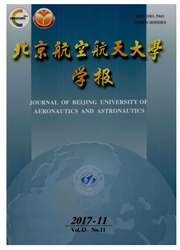

 中文摘要:
中文摘要:
日地系Halo轨道位于平动点附近,且不存在以地球为中心的轨道平面,这使得Halo轨道探测器的姿态描述和建模问题完全不同于近地卫星.针对三轴稳定方式的探测器,给出了2种姿态描述方案:对日定向方案(方案Ⅰ,基于日、地敏感器)和旋转坐标系下定向方案(方案Ⅱ,基于星敏感器).依据两者所定义的不同轨道坐标系,分别建立了姿态动力学模型.分析2类描述方案的相对误差,发现方案I的上限不超过5%,而方案Ⅱ的上限不超过0.005%.并就方案Ⅰ设计了姿态镇定控制器,以验证所提出的姿态描述方案的合理性.结果表明:具体工程应用中应以方案Ⅱ为正常工作模式,并定期修正星历表的误差;方案Ⅰ作为备份,保证探测器的正常运行.
 英文摘要:
英文摘要:
Halo orbit locates about the libration point in the Sun-Earth system and has no orbital plane focusing the Earth, which makes the attitude description and dynamics modeling for Halo-orbit spacecraft is quite different from that for the usual satellite around the Earth. Two different schemes of attitude description were proposed for the spacecraft in the three axis stabilization, sun-orienting scheme (Scheme Ⅰ, using the Sun and Earth attitude sensors) and rotating-reference scheme (Scheme Ⅱ, using the Star attitude sensor). So the attitude dynamics can be modeled from the different orbital coordinates defined by the two schemes. The upper limits of relative errors for the two schemes were estimated theoretically: no more than 5% for Scheme Ⅰ, and 0. 005% for Scheme Ⅱ. A controller was designed for the attitude stabilization to validate the feasibility of the schemes. The research shows that Scheme Ⅱ is set as the normal mode with the astronomical ephemeris periodically corrected, while Scheme Ⅰ is used as the alternate device for the failure mode.
 同期刊论文项目
同期刊论文项目
 同项目期刊论文
同项目期刊论文
 期刊信息
期刊信息
